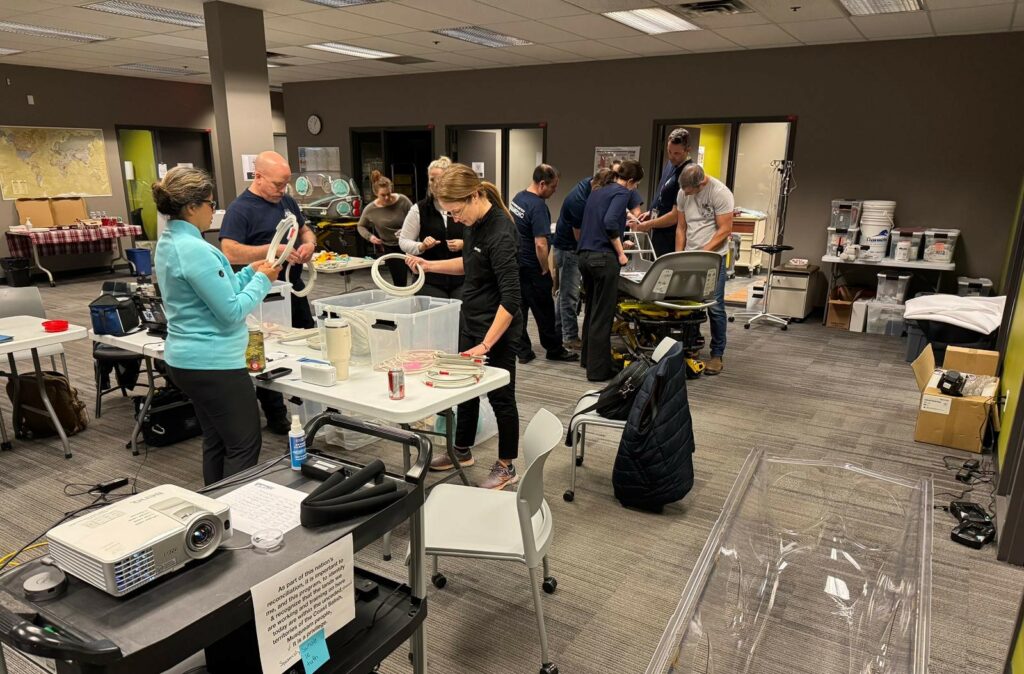EpiTraining: an investment in preparedness
The EpiShuttle is the gold standard for isolation transport in healthcare. Our EpiTraining program is designed to ensure users fully understand the EpiShuttle’s functionality, application, and operational nuances in the context of their own organisations. With options ranging from in-person workshops to e-learning, our EpiTraining is always tailored to our users’ specific challenges and workflows.
However, how does EpiTraining make a difference in our adopters’ organisations, and how do we assess that? Our offer is based on the research done before us, as well as on constant finetuning from the feedback we get from trained EpiShuttle users. What are the insights we collected?
Why Training Matters
Healthcare professionals operate in high-stakes environments where every second counts, even more so when working in emergency settings and/or with infectious diseases and vulnerable patients. Keeping skills continuously brushed up and procedures ready in mind is crucial through training and scenario simulation. Research underscores the value of training in these settings:
Enhanced Preparedness and Efficiency: Studies have shown that simulation training improves emergency response times, reduces errors, and enhances teamwork (1,2,3).
Greater Learning Retention: Compared to didactic teaching, hands-on and simulation-based training lead to better learner outcomes and improved application of knowledge (1,4).
Improved Competency: Tailored and continuous training results in measurable improvements in critical tasks, such as recognizing respiratory decompensation or managing airways in emergency medical services (EMS) (5).
Error Reduction: Regular and targeted training reduces the frequency of medical errors, improving patient outcomes and overall procedural quality (4).
What Our Data Tells Us
Since November 2022, we’ve surveyed participants across six countries to gauge the impact of EpiTraining. The results show that EpiTraining succeeds in doing what it sets out to do: empower EpiShuttle users for more efficient, safer and confident transport of highly infectious and vulnerable patients. In particular, some of our indicators speak to the results of the scientific literature.
Satisfaction: 76% of participants reported being very satisfied with the content, and 100% praised our trainers.
Preparedness: 93% felt confident in using the EpiShuttle post-training.
Knowledge Improvement: On average, participants’ confidence levels in their EpiShuttle implementation skills increased by 124% after training.
Ongoing Training Needs: 90% of respondents expressed a need for periodic retraining, with 87% recommending a frequency of at least a training per year.

Bridging Practice with Evidence
Our data aligns with broader findings from the healthcare industry. For example, simulation training has been shown to significantly improve team-based care and critical task performance. By combining hands-on practice with expert instruction, our EpiTraining ensures that healthcare providers are not only technically proficient but also confident and prepared for real-world applications.
In the words of one of our trained users:
“EpiTraining has been instrumental in helping us implement the EpiShuttle across various hospitals in France. Thanks to the creation of in-house experts through EpiGuard training, we have now developed EpiShuttle Standard Procedures and have the capacity to lead training and exercises independently.”
Hélène Coignard, Emergency physician, COREB, AP-HP
Conclusion
Our data aligns with broader findings from the healthcare industry. For example, simulation training has been shown to significantly improve team-based care and critical task performance. By c
Medical training is not just a box to check; it is a vital investment in safety, efficiency, and preparedness. At EpiGuard, we are committed to ensuring that every EpiShuttle adopter receives the knowledge and skills they need to excel.
If you’re interested in learning more about our training programs or scheduling a session, visit our website or contact us directly below. Together, we can make a difference in patient care and clinical excellence.
References
1.Susanna R. Magee, Robin Shields & Melissa Nothnagle (2013) Low Cost, High Yield: Simulation of Obstetric Emergencies for Family Medicine Training, Teaching and Learning in Medicine, 25:3, 207-210, DOI: 10.1080/10401334.2013.797353
2.Cates LA. Simulation training: a multidisciplinary approach. Adv Neonatal Care. 2011 Apr;11(2):95-100. doi: 10.1097/ANC.0b013e318210d16b. PMID: 21730896.
3.Elendu C, Amaechi DC, Okatta AU, Amaechi EC, Elendu TC, Ezeh CP, Elendu ID. The impact of simulation-based training in medical education: A review. Medicine (Baltimore). 2024 Jul 5;103(27):e38813. doi: 10.1097/MD.0000000000038813. PMID: 38968472; PMCID: PMC11224887.
4.Kothari K, Zuger C, Desai N, Leonard J, Alletag M, Balakas A, Binney M, Caffrey S, Kotas J, Mahar P, Roswell K, Adelgais KM. Effect of Repetitive Simulation Training on Emergency Medical Services Team Performance in Simulated Pediatric Medical Emergencies. AEM Educ Train. 2020 Nov 5;5(3):e10537. doi: 10.1002/aet2.10537. PMID: 34099990; PMCID: PMC8166302.
5.Green A, Hug M. Simulation Training and Skill Assessment in EMS. [Updated 2021 May 9]. In: StatPearls [Internet]. Treasure Island (FL): StatPearls Publishing; 2022 Jan-. Available from: https://www.ncbi.nlm.nih.gov/books/NBK560562/